Key thing is that models for T/S extraction and radiator simulation should match. By extracting parameters with VCAD you can be quite certain that radiator simulation is compatible with extracted parameters because radiator simulation works with both standard T/S and LOG model. But if you extract with REW, the best match with VCAD is not available because standard T/S is the only compatible model. I doubt that LEAP would understand Ritter 3PC or LOG model.
But all this is still total overkill for simple sealed box.
Sorry Kimmo
I cann't understand you clearly because my poor English and lack of basic knowledge about transducers.
You mentioned "radiator simulation", "standard T/S and LOG model" and "Ritter 3PC" "Creep B",it's the first I heard some of these words, I don't understand.
You mean for EBP value around 86, I can just simply use a sealed box?
Actually I would like to try a Ported Box if possible,but that's not simple.
I also want to try to put some damping materials and fibre glass into the box, maybe LEAP is a good choice in this way.
Hi, icbcodc. Just curious, how did you solve the help file problem? Are you able to click on a help button in the program and have it open the help file to the right location?
Thanks.
You can use old winhlp32 in WinXP to replace the winhlp programe in Win7 or Win10, but more important and complicated is to configure the registry information correspodingly.
So someone made a package including old winhelp32.exe and the cmd file.
Just run the cmd file to finish all the job.
I've try this package in my win10 64bit and win7 64bit, it's simple and working, there is Avira antivirue installed in all my two computers, it's safe.
Here is the original URL I found this method and package,it's in Chinese.
win10下.hlp文件解决方法-百度经验
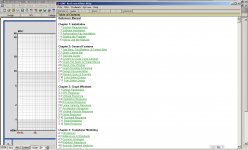
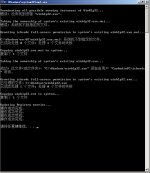
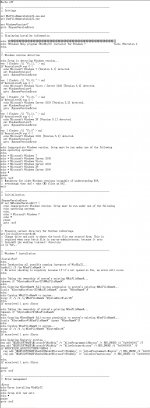
View attachment win10win7_winhlp32_InstallationPackage.zip
Last edited:
You mentioned "radiator simulation", "standard T/S and LOG model" and "Ritter 3PC" "Creep B",it's the first I heard some of these words.
* Radiator ~ direct radiator ~ simple driver+enclosure system.
* standard T/S ~ traditional T/S ~ just Thiele/Small parameters without modern creep parameters such as beta and different electro-mechanical model for simulation.
* Ritter 3PC and LOG model ~ modern and more accurate electro-mechanical models of transducers which cannot be simulated with programs having simple traditional T/S model only.
You mean for EBP value around 86, I can just simply use a sealed box?
Of course Qts=0.68 is possible also in vented box but it needs huge box or damping which kills the resonance.
Sealed is more natural for those parameters but bass extension won't be impressive.
I also want to try to put some damping materials and fibre glass into the box, maybe LEAP is a good choice in this way.
I'm confident that LEAP includes filling simulation, though at least simple % or grams value is quite worthless. Typically good principle for filling is "minimum amount in correct locations". Basic simulation does not give that answer. Common sense with small practice works much better.
Filling is also ideologically a bit questionable with modern high Qm drivers. Manufacturers try to create lossless and dynamic drivers and then at least some diyers are willing to kill the product by dumping turbulent non-linear resistive material too much to bad location
I'm confident that LEAP includes filling simulation, though at least simple % or grams value is quite worthless.
Hi Kimmo.
Thank you for your explanations.
I still need sometime to know box simulation and estimation and building.
For beginners, I found WINISD is the simplest one to use and VCAD is also not very hard but you need to get a T/S parameters with small errors.
LEAP 5.0 is the hardest one for beginners, I still can not make sure whether the T/S parameters I input into it are correct.
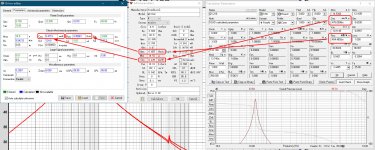
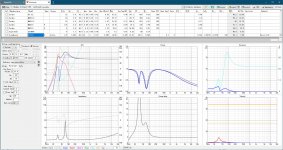
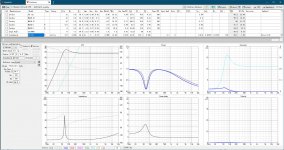
I use the T/S parameters calculated in VCAD to input into WINISD and get two box SPL simulations.
The simulations between VCAD and WINISD looks similar.
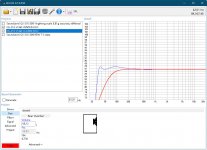
...but you need to get a T/S parameters with small errors.
Just reminding that Error value in Extended Z model group in VCAD is not specially from T/S parameters. Primary purpose is to inform how close extended impedance model by Le, Leb, Ke and Rss is to reality i.e. free air impedance measurement. Another purpose is to inform difference between simulated and measured around resonance peak at fs. That has significance in DCR/Re estimation with dual added mass method.
I still can not make sure whether the T/S parameters I input into it are correct.
Already shown differences by simulating driver in infinite baffle and comparing to free air measurement. VCAD is the closest match full range. speakerbench.com very good match at LF, but small differences at HF due to differences in extended Z model parameters. Worst match with T/S by REW. Qm looks way too high. I've not verified has Ritter 3PC something to do with this.
The simulations between VCAD and WINISD looks similar.
Those two are exact match because VCAD is using the same formulas for calculation with T/S than WinISD. Another similarity is that both are made in Kuopio
Last edited:
Primary purpose is to inform how close extended impedance model by Le, Leb, Ke and Rss is to reality i.e. free air impedance measurement. Another purpose is to inform difference between simulated and measured around resonance peak at fs. That has significance in DCR/Re estimation with dual added mass method.
So that means the Error value is meaningful for Le, Leb, Ke and Rss and Re.
Worst match with T/S by REW.
That's a terrible news. REW can only calculate T/S parameters and simulate the impedance curve once for one set of measurements. John has his own way to estimate the simulated and measured plots.
Qm looks way too high.I've not verified has Ritter 3PC something to do with this.
You mean QMS?
Another similarity is that both are made in Kuopio
That's cool. I know Nokia.

So that means the Error value is meaningful for Le, Leb, Ke and Rss and Re.
The most meaningful, because those parameters affect to impedance response over a wide range. Impedance peak by T/S (Cms, Mms and Rms) is around fs.
That's a terrible news... John has his own way to estimate the simulated and measured plots.
Not so terrible. He will fix calculation if there's something wrong and someone informs him. Traditional T/S parameters should be quite equal no matter which program calculate them.
You mean QMS?
Sure.
You can use old winhlp32 in WinXP to replace the winhlp programe in Win7 or Win10, but more important and complicated is to configure the registry information correspodingly.
So someone made a package including old winhelp32.exe and the cmd file.
Just run the cmd file to finish all the job.
I've try this package in my win10 64bit and win7 64bit, it's simple and working, there is Avira antivirue installed in all my two computers, it's safe.
I apologize for only just now seeing this and responding.
I'm not comfortable just running it so I looked at the *.cmd file. It appears to be designed to work on Windows versions up to Win7. If it ran correctly on Win10, well, I'd be surprised but I didn't examine it that carefully.
But let's be clear: WinHelp has been deprecated for several past versions of Windows. Microsoft provided "fixes" for all versions prior to Win10. As of Win10, Microsoft no longer provides the fixes to have WinHelp work with legacy applications. (See here for one of many MS forum posts: Winhlp32.exe for Windows 10 64 bit to access legacy help files working - Microsoft Community)
I've previously posted on how to use a copy of Win7's winhlp32.exe on Win10 to open the LEAP help files. At that point, you can navigate within the LEAP help as always.
But that's not the problem that I was hoping to solve. What I want is to open LEAP ES or CS on Win10, click on a "help" button in the LEAP GUI, and have WinHelp open up to the "context-sensitive" relevant topic in the LEAP help. Is that what your code/fix provides?
Thanks and sorry for the delayed response.
One more comparison: impedance response in IB with standard T/S (LOG model unchecked -> beta=0) by VCAD compared to free air measurement. This is also good enough for typical radiator simulations.
Comparison is easy to repeat with any other simulator supporting IB and extended impedance model with Le, Leb, Ke and Rss.
Kimmo, impedance curves of the same loudspeaker measured under the free air condition and in the infinite baffle should be different because the air mass loading to the cone in IB is twice as in free air (i.e. IB lowers lodspeaker resonance).
Last edited:
I got the Enclosure shop working. Is there steps for Filter Shop to work?
Glad ES is working. I don't have FS. If it has a USB dongle, you may be able to test-sign the driver and run in the test configuration as for ES & CS.
If you try that, please share your results.
- Home
- Design & Build
- Software Tools
- LinearX Crossover Shop and Enclosure Shop and Windows 10